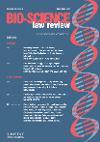Bio-Science Law Review - Volume 19 - Issue 6

Please note that this title is now available via our online reader - this service is included with the print subscription - subscribers wishing to access this service please contact us on ltp@lawtext.com
Articles
Resolving Access and Benefit-Sharing from Biodiversity: Towards an Effective Global Benefit-Sharing Mechanism on Digital Sequence Information
Bart Van Vooren and Yuliya Gevrenova
Covington & Burling Llp, Brussels
In December 2022, at COP 15 in Montreal, parties to the Convention on Biodiversity (CBD) agreed an ambitious new global biodiversity framework with four goals for 2050 and 23 targets for 2030 and called for an urgent increase in funding in order to finance these objectives. One prominent strategy to raise private-sector contributions is the ‘multilateral mechanism on benefit-sharing from the use of digital sequence information on genetic resources’ (‘MLM-DSI’), officially created by COP decision 15/9. On 1 November 2024, COP decision 16/2 adopted the ‘modalities for operationalising’ the new mechanism and called it the ‘Cali Fund’. Although labelled a ‘multilateral mechanism’, it does not align neatly with multilateral principles. nor does it implement the bilateral transactional model. Instead, negotiators produced a ‘hybrid system’ that arguably raises more questions than it answers. This article assesses why this ‘hybrid system’ fails to fulfil the legal certainty criterion in paragraph 9 of decision 15/9, and how CBD parties can address the resulting flaws that undermine the Cali Fund’s functionality.
Cell and Gene Therapy Licensing: Complex Regulatory Pathways Necessitate Careful Scrutiny of Financial Milestones
Luca Cericola, Alex Denoon and Ellen Lambrix
Bristows, London
Cell and Gene Therapies (‘CGTs’) are complex products with regulatory pathways which are still evolving. Conventionally, milestone payments to the licensor are triggered upon the licensee’s successful achievement of a particular regulatory or commercial event, such as commencement of specific clinical trial phases, obtaining a marketing authorisation, first commercial sale, or hitting certain sales thresholds. It is crucial that the triggers for these milestone payments are clear. However, when it comes to CGT products, the differences and uncertainties in regulatory pathways and blurring of boundaries between clinical trial phases mean that achieving clarity regarding triggers for clinical and regulatory milestones can be challenging. This article uses examples of the clinical and regulatory pathways taken by certain CGT products in recent years to highlight key points that parties who are negotiating and drafting CGT IP licences should be aware of, and explores how such parties can consider addressing these challenges.
Case Comments
The CJEU Acts Promptly to Clarify Article 3(D) Regulation 469/2009 but does not resolve divergent approaches to interpreting Article 3(B)
Mike Snodin
Park Grove IP Ltd
Nottingham
This article discusses the interpretation of Article 3(d) that is set out in the ruling from the CJEU in C–181/24 (genmab) as well as aspects of the Court’s reasoning which provide hints as to how it is likely to approach future disputes over the interpretation of provisions that make reference to Marketing Authorisations. It also discusses questions arising from the genmab case that have not yet been resolved, as well as the case law and interpretative approaches which point to likely, or at least possible, answers to those questions.
Limited Right of the intervener to attack validity of the patent before the United Patent Court?
Dr Gabor Mester
Grund Intellectual Property Group, Munich
A development in procedural law, that has implications for all branches of technology and, ultimately, business, relates to the right of a so-called ‘forced intervener’ in proceedings before the UPC. A forced intervener is a (natural or legal) person called upon by the court to take part in litigation initiated by other parties, with the decision in the litigation being made binding on him, whether he takes part or not. A common use of this instrument is against suppliers of allegedly patent-infringing products by their customers who are sued for patent infringement. If the customer is found to have infringed the patent with the product, this finding automatically applies also to the supplier, who might find himself ultimately liable for the damages of infringement. The supplier is thus forced to take part in the proceedings and, by defending his customer, to defend himself. Recent decisions by the UPC raise the grave concern that a forced intervener may be precluded from raising, in any forum, the invalidity of the patent in suit, for the infringement of which he could eventually held be liable
Patent Settlements under EU Competition Law: The EU Court of Justice takes a tough stance against value transfers from originators to generics:
EUROPEAN COMMISSION v SERVIER SAS, SERVIER LABORATOIRES LTD, LES LABORATOIRES SERVIER SAS
Ingrid Vandenborre, Michael Frese, Antonio Cammalleri and Leonor Catela
Skadden, Arps, Slate, Aeagher & Flom Llp, Brussels
In June 2024, the CJEU handed down two long-awaited judgments in the Commission’s perindopril case, concerning patent settlement agreements between an originator and several generic manufacturers. The Court rejected the notion that granting a licence in some markets could justify restrictions on market entry in other markets, and emphasised that any procompetitive effects in licensed markets cannot compensate for anticompetitive restrictions elsewhere.
